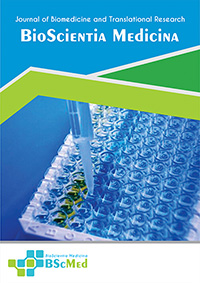Main Article Content
Abstract
Background: Gastrointestinal stromal tumors (GISTs) are the most common mesenchymal neoplasms of the digestive tract, primarily driven by mutations in KIT or PDGFRA genes. CD117 (c-KIT) expression is a key diagnostic marker, while the Ki67 labeling index reflects cellular proliferation. Risk stratification, often using modified NIH criteria based on tumor size, mitotic rate, and location, guides prognosis and treatment. This study investigated the distinct roles of CD117 and Ki67 expression in relation to risk stratification in GIST patients.
Methods: This cross-sectional analytical study examined 27 GIST cases diagnosed between January 2021 and December 2024 from three Indonesian hospitals. Formalin-fixed paraffin-embedded tissues were analyzed using immunohistochemistry for CD117 (clone YR145) and Ki67 (clone K2). CD117 positivity was defined as ≥5% tumor cell staining, and high Ki67 expression as >10% nuclear staining. Risk stratification utilized the modified NIH criteria. The Chi-square test assessed correlations (p<0.05 significance).
Results: The cohort predominantly comprised patients >50 years (66.7%), males (59.3%), with gastric tumors (51.9%), large tumor size (>5cm in 96.3%), spindle cell morphology (77.8%), and high mitotic rates (74.1%). Most cases (85.2%) were classified as high-risk. CD117 was positive in 81.5% (22/27) of cases but showed no significant correlation with risk stratification (p=0.561). High Ki67 expression was found in 74.1% (20/27) of cases and demonstrated a significant positive correlation with high-risk stratification (p=0.002). The combination of CD117 and Ki67 status also showed a significant association with risk stratification (p=0.001).
Conclusion: While CD117 expression remains a cornerstone for GIST diagnosis and targeted therapy selection, it did not correlate significantly with risk stratification in this cohort. Conversely, a high Ki67 labeling index was significantly associated with high-risk GIST, underscoring its potential as a valuable prognostic marker alongside established risk stratification parameters.
Keywords
Article Details
As our aim is to disseminate original research article, hence the publishing right is a necessary one. The publishing right is needed in order to reach the agreement between the author and publisher. As the journal is fully open access, the authors will sign an exclusive license agreement.
The authors have the right to:
- Share their article in the same ways permitted to third parties under the relevant user license.
- Retain copyright, patent, trademark and other intellectual property rights including research data.
- Proper attribution and credit for the published work.
For the open access article, the publisher is granted to the following right.
- The non-exclusive right to publish the article and grant right to others.
- For the published article, the publisher applied for the Creative Commons Attribution-NonCommercial-ShareAlike 4.0 International License.





